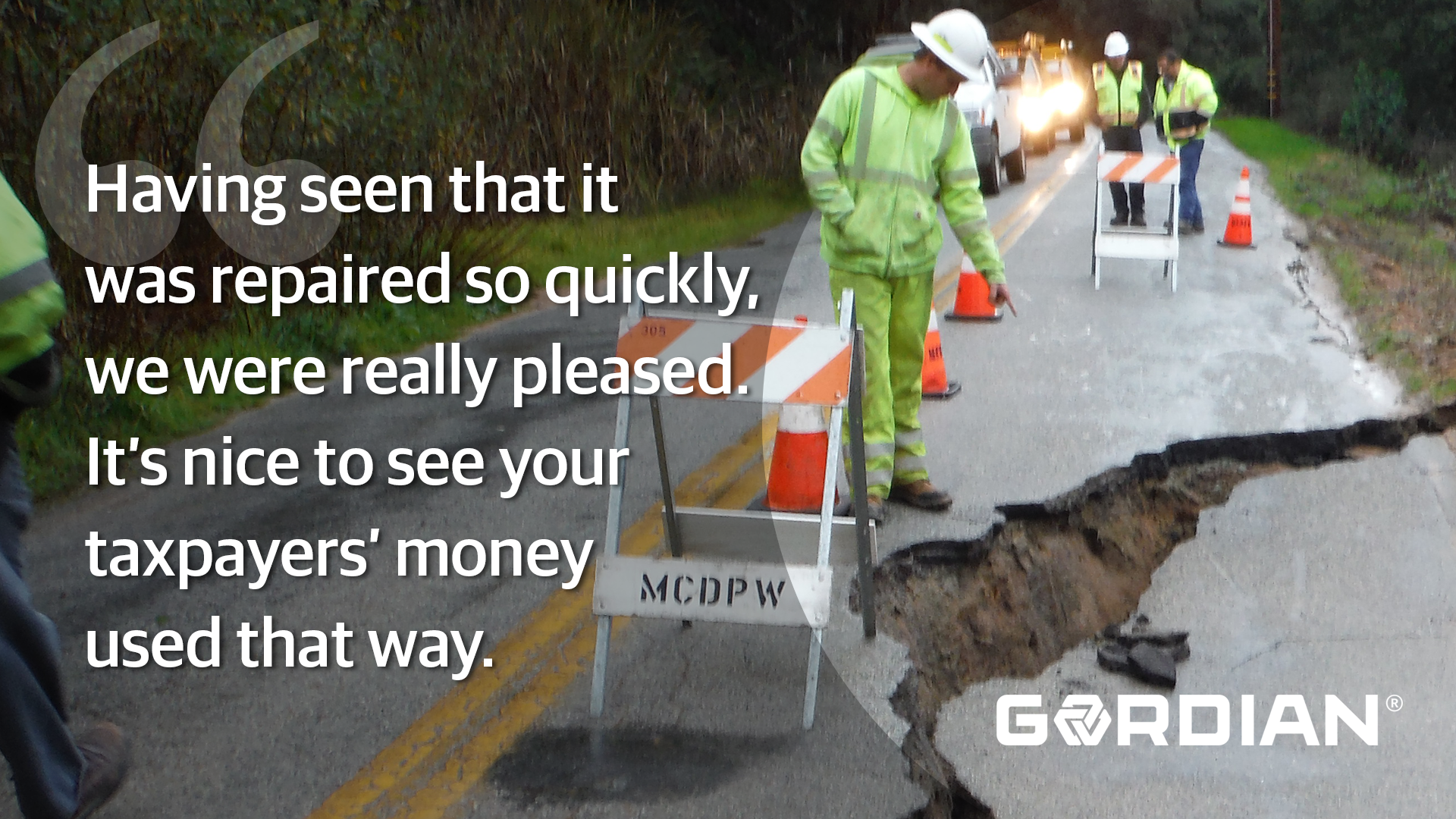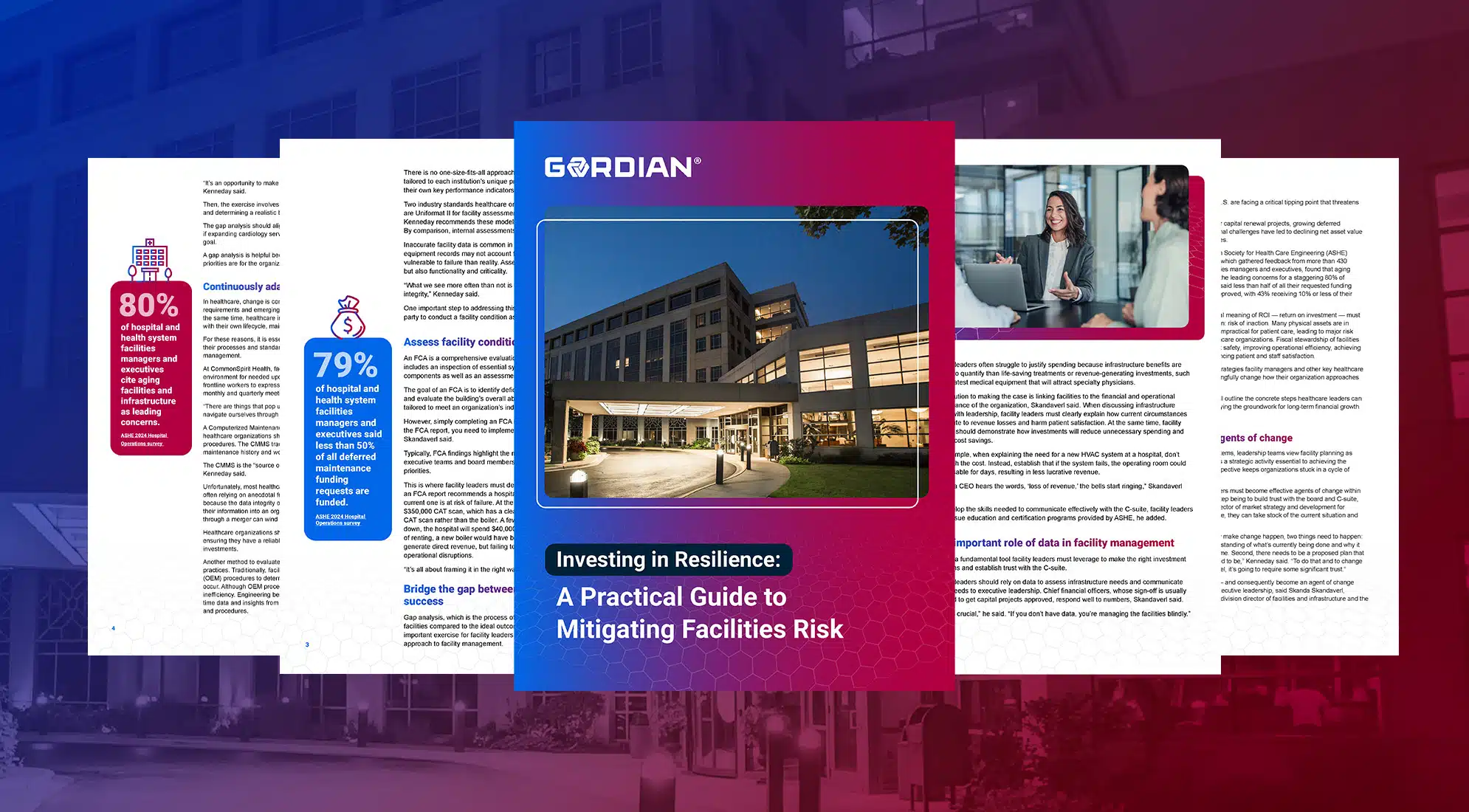
Maintaining Community Infrastructure: A Closer Look at the 2025 ASCE Report Card
June 30, 2025
Key Points:
- What is the ASCE Report Card?
The American Society of Civil Engineers (ASCE) Report Card is a comprehensive assessment of U.S. infrastructure, graded across categories like roads, schools, water systems, and public buildings. In the 2021 report, America’s infrastructure received a C- grade, signaling aging systems and underinvestment—issues that directly impact facilities teams managing public assets. - Why It Matters for Facilities Leaders
The report highlights the urgent need for proactive capital planning and data-driven asset management. Facilities teams must address deferred maintenance and aging infrastructure while navigating limited budgets. The ASCE Report Card provides a national context that can help justify funding requests and strategic investments. - How Gordian Supports Infrastructure Improvement
Gordian helps facilities teams respond to these challenges with tools like Facility Condition Assessments (FCAs) and Job Order Contracting (JOC). These solutions enable organizations to assess asset health, prioritize repairs, and execute projects efficiently—aligning local action with national infrastructure goals.
2025 ASCE Report Card: Optimizing Community Infrastructure
Published every four years by the American Society of Civil Engineers (ASCE), the Report Card for America’s Infrastructure assigns letter grades to over a dozen categories, from aviation to wastewater. The ASCE report card is bigger than an evaluation by a team of engineers; it’s a bellwether for the quality of American life. It highlights areas of need and potential investments that can significantly improve community assets and the lives of the people who call those communities home.
The ASCE released its latest report card in March of 2025, along with new analysis and suggestions for improving infrastructure assets and, by extension, communities. The 2025 overall grade was a C, up from a C- in 2021, a jump the ASCE attributes to the 60,000+ projects funded by the Infrastructure Investments and Jobs Act (IIJA). For the first time since 1998, no infrastructure category was rated a D-, and among the ASCE’s 18 categories, eight grades increased.
In this blog post, we’ll provide analysis and commentary on the grades the ASCE gave to infrastructure with broad application in the hopes of creating a clearer understanding of the current state of these crucial assets and what needs to be done to improve them.
Infrastructure Sector 1: Roads
2025 Grade: D+
2021 Grade: D
America is home to 4.1 million miles of public roadways and, per the ASCE, some 39% of major roads are in poor or mediocre condition. That statistic should make any driver nervous considering congested or compromised surfaces cost the average driver an estimated $1,400 per year, but it’s an improvement over 2020, when 43% of roads were considered poor or mediocre.
The IIJA offered more than $591 billion for road improvements, and that funding will go a long way to making every ride smoother. However, there is still work to be done, and a $684 billion ten-year funding gap looming over U.S. roads.
When it comes to keeping roadways safe and functional, extreme weather is a major obstacle and one the transportation industry is partially responsible for creating. Transportation accounted for the most sizable portion (28%) of total U.S. greenhouse gas emissions in 2022, per the 2025 ASCE Report Card. Most of these emissions (80%) came from cars and medium- and heavy-duty trucks.
Infrastructure Sector 2: Schools
2025 Grade: D+
2021 Grade: D+
The schoolhouse is the heartbeat of the community. It’s where children go to learn, make friends and develop their talents. It’s where citizens come together to exercise their right to vote. It’s where neighbors gather to proudly root their local sports stars to victory. And while public school enrollment is projected to hit 56.8 million by 2026, there’s not a lot of available data about the conditions of U.S. school facilities, due to inconsistent reporting. Here’s what we know.
The average age of an American school is 49 years old, meaning many are at or beyond their design life. The ASCE estimates that fewer than half of public school buildings have undergone meaningful renovations or improvements since their original construction, and less than one-third have been improved since 2010. Investments in the built environment are, and always have been, dismal. According to the ASCE, in 2021-2022, only 10% of total school funding went to facility expenses. And it’s not like the need doesn’t exist.
The annual funding gap for repairing the nation’s public schools ballooned from $60 billion in 2016 to $85 billion in 2021. According to a 2020 Government Accountability Office (GAO) report, 41% of school districts needed to update heating, ventilation and air conditioning (HVAC) systems. Separately, a 2021 study estimated that 13,700 additional schools must add air conditioning because of higher daytime temperatures, representing more than $40 billion in investment needs.
This is not to say there have not been attempts at improving school conditions. Ahead of the 2021-2022 school year, the federal government delivered $24.2 billion in COVID-19 federal assistance funds. However, schools were permitted to spend that funding how they saw fit, and only 10% of that spending – close to $2.5B – went to capital expenditures.
See how partnerships can enhance educational facilities management in this free eBook.
Infrastructure Sector 3: Levees
2025 Grade: D+
2021 Grade: D
Do you know how many Americans live and work behind a levee? The number might surprise you: 23 million, according to the ASCE Report Card. Further, the nation’s levees protect $2 trillion in property, seven million buildings and five million acres of farmland. They are critical to the safe movement of people and goods, a vital aspect of everyday life.
Yet we’re not sure how many there are or what state they are in. Not ideal.
There is no centralized database of levee condition data, no single source of truth. The National Levee Database contains over info on 24,000 miles of levees across the U.S., but that number is only a fraction of the real number, which reaches as high as 100,000 levee miles per some estimates. Of the 24,000 miles in the database, only about one-third have been assessed for risk to populations in relation to condition. Of those levees assessed for risk, 84% are rated as low or very low risk, and about 3% are rated as high or very high, facts Americans should find comforting.
Levee performance and condition can be affected by many factors, including extreme weather. As climate change increases the frequency and severity of rain events, the added strain on levees (97% of which are earthen) is likely to raise the total cost of levee rehabilitation projects.
Recommendations for Improving Critical Infrastructure
As part of its report card, the ASCE offers suggestions for raising the grades of this critical infrastructure. Synthesizing this advice brings several patterns to the fore and reveals helpful activity that transcends a specific infrastructure category. These are solutions that apply universally.
- More funding. Across the board, the ASCE recommends fundraising via taxes, user fees, grants and appropriations and finding creative avenues to raise money.
- Strategic asset management. Roads, schools and levees must have their conditions assessed regularly. The data captured in these assessments help owners develop budgets to improve asset conditions and create an informed prioritization schedule.
Gordian, for instance, offers a suite of condition assessment and facilities capital planning tools that organizations across North America use to communicate and prioritize needs and risks, generate long-term strategies and estimate expenses. Foundational to all Gordian solutions are industry standard RSMeans™ Data construction costs, the most accurate database available. Our technologies provide the data and our people provide the insight to help leaders optimize their assets and build better communities.
In the case of schools and levees, the construction of a secure condition database should be a priority. This, too, may require assistance from industry.
- Emphasize resilience and emergency response. It’s impossible to divorce the 2025 ASCE Report Card for America’s Infrastructure and climate change. Extensive rain and flooding damage and overwhelm roads and levees. Extreme heat and cold can make life miserable for teachers and students in portable classrooms, and public school buildings often double as emergency shelters when disaster strikes. Again, Gordian can help.
Our Job Order Contracting (JOC) solution is an ideal vehicle for doing disaster prep work or quickly completing emergency response projects. That’s because JOC empowers organizations to complete many projects with one contract. This unique, single-solicitation approach reduces construction procurement time by weeks and uses verified, preset prices for incredible cost control. When work needs to be done quickly, done well and within budget, there’s no better solution than Gordian’s Job Order Contracting. Use this calculator to find out if JOC is a viable option your next infrastructure project.
More Infrastructure Insights to Come
Believe it or not, we’ve only covered a fraction of the categories from ASCE’s Infrastructure Report Card. We’ll be back with more analysis of the ASCE’s findings in future blog posts.
Have a shovel-ready infrastructure project and access to a shared JOC contract? Get started today.
Share this:








